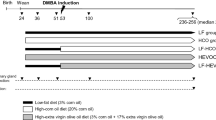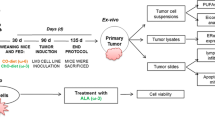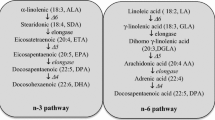Abstract
Female athymic nude mice were implanted subcutaneously with human breast carcinoma MDA-MB231. Seven to ten days later, the mice were divided into groups and fed a purified diet containing the following types of fat (% of diet):(i) 20% corn oil (CO); (ii) 15% CO:5% fish (menhaden) oil (FO); (iii) 10% CO:10% FO; (iv) 5% CO:15% FO; (v) 1% CO:19% FO; and (vi) 1% CO:19% FO plus antioxidants (α-tocopherol acetate, 2000 IU/kg diet and tertiary butyl-hydroquinone, 2% of the total fat). The linoleic acid levels (% of diet) of the groups were 12.0, 9.1, 6.2, 3.3, 0.9 and 0.9%, respectively. After 6–8 wk, the carcinomas were assessed for tumor volume (cm3) and assayed for thiobarbituric acid reactive substances (TBARS). Human breast carcinoma growth was suppressed in mice consuming FO diets without antioxidants as compared to mice fed CO; the greater the amount of dietary FO fed, the greater the carcinoma growth suppression (P<0.05). The addition of antioxidants to the FO diet significantly (P<0.05) reversed the FO-induced carcinoma growth suppression. Concentrations of TBARS in the human breast carcinomas were increased in all the FO (without antioxidants) fed mice, compared to mice fed CO; the level of increase in TBARS was directly related to the increase in the level of FO fed (P<0.05). The addition of antioxidants to the FO diet significantly (P<0.05) reduced the concentration of TBARS in the breast carcinomas. Thus, these results provide evidence that dietary FO can significantly suppress growth of human breast carcinoma MDA-MB231, even in the presence of substantial amounts of linoleic acid (3.3–9.1%). The inhibitory effect of FO on growth of these carcinomas was associated with an increased concentration of TBARS in the tumor tissue. In conclusion, dietary FO induced suppression of human breast carcinoma growth is a function, at least in part, of an accumulation of lipid peroxidation products in the tumor tissues.
Similar content being viewed by others
Abbreviations
- CO:
-
corn oil
- DHA:
-
docosahexaenoic acid
- EPA:
-
thiobarbituric acid reactive substances
- TBHQ:
-
tertiary butylhydroquinone
References
Welsch, C.W. (1992)Cancer Res. 52, 2040s-2048s.
Karmali, R.A., Marsh, J., and Fuchs, C. (1984)J. Natl. Cancer Inst. 73, 457–561.
Jurkowski, J.J., and Cave, Jr., W.T. (1985)J. Natl. Cancer Inst. 74, 1145–1150.
Gabor, H., and Abraham, S. (1986)J. Natl. Cancer Inst. 76, 1223–1229.
Fernandes, G., Frieduchs, W., and Schultz, J. (1989)Breast Cancer Res. Treat. 14, 179A.
Pritchard, G.A., Jones, D.L., and Mansel, R.E. (1989)Brit. J. Surg. 76, 1069–1073.
Borgeson, C.E., Pardini, L., Pardini, R.S., and Reitz, C. (1989)Lipids 24, 290–295.
Gabor, H., Blank, E.W., and Ceriani, R.L. (1990)Cancer Lett. 52, 173–178.
Gonzalez, M.J., Schemmel, R.A., Gray, J.I., Dugan, Jr., L. Sheffield, L.G., and Welsch, C.W. (1991)Carcinogenesis 12, 1231–1235.
Braden, L.M., Carroll, K.K. (1986)Lipids 21, 285–288.
Abou-El-Ela, S.H., Prasse, K.W., Carroll, R., Wade, A.E., Dharwadkar, S., and Bunce, O.R. (1988)Lipids 23, 948–959.
Ip, C., Carter, C.A., and Ip, M.M. (1985)Cancer Res. 45, 1997–2001.
Marmer, W.N., Maxwell, R.J. (1981)Lipids 16, 365–371.
Crackel, R.L., Gray, J.I., and Pearson, A.M. (1988)Food Chem. 28, 187–196.
Buege, J.A., and Aust, S.D. (1978)Methods Enzymol. II, 302–310.
Willis, E.D. (1969)Biochem. J. 113, 315–319.
Lowry, O.H., Rosebrough, N.J., Farr, A.L., and Randall, R.J. (1951)J. Biol. Chem. 193, 265–275.
Wilkinson, L. (1989)Systat: The System for Statistics, SYSTAT, Inc., Evanston.
Abou-El-Ela, S.H., Prasse, K.W., Farrell, B.L., Carroll, R., Wade, A.E., and Bunce, O.R. (1989)Cancer Res. 49, 1434–1440.
National Research Council (1978)Nutrient Requirements for Laboratory Animals Nutrient Requirements of Domestic Animals, No. 10, p. 44, National Academy of Sciences, Washington, D.C.
Gonzalez, M.J., Gray, J.I., Schemmel, R.A., Dugan, Jr., L., and Welsch, C.W. (1992)J. Nutr. 122, 2190–2195.
Gonzalez, M.J. (1992)Med. Hypotheses 38, 106–110.
Spector, A.A., and Yorek, M.A. (1985)J. Lipid Res. 26, 1015–1035.
Spector, A.A., and Burns, C.P. (1987)Cancer Res. 47, 4529–4537.
Farber, J.L., Kyle, M.E., and Coleman, J.B. (1990)Lab. Invest. 62, 670–679.
Roubal, W.T., and Tappel, A.L. (1966)Arch. Biochem. Biophys. 113, 5–8.
Reiss, U., and Tappel, A.L. (1973)Lipids 8, 199–202.
Dianzani, M.U. (1982)Free Radicals, Lipid Peroxidation and Cancer (McBrien, D.C., and Slater, T.F., eds.) pp. 129–158, Academic Press, London.
Bull, A.W., Nigro, N.D., and Marnett, J.J. (1988)Cancer Res. 48, 1771–1776.
Glasgow, W.C., Afshari, C.A., Barrett, J.C., and Eling, T.E. (1992)J. Biol. Chem. 267, 10771–10779.
Wattenberg, L.W., Loub, W.D., Lam, L.K., and Speier, J.L. (1976)Fed. Proc. 35, 1327–1331.
Hirose, M., Masuda, A., Inoue, T., Fukushima, S., and Ito, N. (1986)Carcinogenesis 7, 1155–1159.
McCormick, D.L., Major, N., and Moon, R.C. (1984)Cancer Res. 44, 2858–2863.
Ip, C. (1982)Carcinogenesis 3, 1453–1456.
King, M.M., and McCay, P.B. (1983)Cancer Res. 43, 2485s-2490s.
Beth, M., Berger, M.R., Aksoy, M., and Schmahl, D. (1987)Br. J. Cancer 56, 445–449.
Author information
Authors and Affiliations
About this article
Cite this article
Gonzalez, M.J., Schemmel, R.A., Dugan, L. et al. Dietary fish oil inhibits human breast carcinoma growth: A function of increased lipid peroxidation. Lipids 28, 827–832 (1993). https://doi.org/10.1007/BF02536237
Received:
Revised:
Accepted:
Issue Date:
DOI: https://doi.org/10.1007/BF02536237




